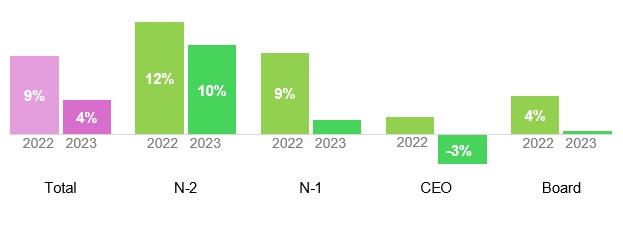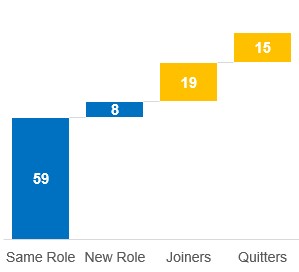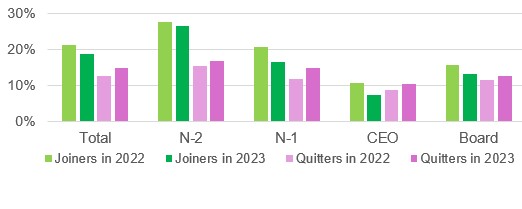Despite widespread cost-cutting, the demand for executives is increasing, underscoring the continued importance of their roles within medium and large companies worldwide.
Evolution of corporate ranks
The number of executives in corporate leadership has surged, with a 9% increase in 2022 followed by a subsequent 4% rise in 2023. The N-2 roles (reporting to an executive reporting to the CEO) saw the largest growth rates of 12% in 2022 and 10% in 2023.
Their growth was highest in functional roles, armed with unique expertise. Why? They play crucial roles in navigating complex corporate environments, especially within fast evolving domains such as governance, control, culture, product, and technology.
There has been a noticeable slowdown in generalist roles such as board members, CEOs, and management positions. This trend is attributed to the strategic streamlining of non-essential activities, even within industry giants like Apple, Amazon, and Google.
Executive retention
When looking at 100 executives who worked at a company in 2023, two-thirds worked the full year at the company: 59 held the same job, and 8 transitioned to a new job within the company.
Out of the remaining third, 19 executives joined, and 15 executives quit during 2023 highlighting the fast pace at which companies keep tuning their organizational charts.
Variations of executive tenure by role
Executive tenure remained stable. CEO and board roles demonstrated the highest continuity, while roles in people, market, and technical domains confirmed lower continuity rates.
Less inflows and more outflows
The dynamics of executive movement showcased a decrease in inflows and an increase in outflows within companies in all segments.
Particularly noteworthy was the inflow of joining N-2 executives, reducing from 28% to 26%, while their outflow of quitting N-2 executives rose to 17% from 15%, underscoring the growing need for new expertise.
More agile than ever
Within the organizational charts, the number of executive movements (executives having a new role in their company, executives joining, or executives quitting) increased by another 2% between 2022 and 2023.
The highest acceleration was observed in management and corporate functions, confirming the need for robust onboarding and offboarding processes to manage executive transitions effectively.
Takeaways
The corporate landscape has witnessed a significant surge in top-level executives, signaling a persistent demand for managerial talent amid cost-saving measures. Analysis spanning 2022 to 2023 reveals growth in specialized roles, especially in N-2 positions, underscoring their pivotal role in navigating complex corporate environments.
Notable trends include a slowdown in generalist roles, stable executive tenure, and a shift in executive movement dynamics. With a focus on optimizing talent portfolios, companies are adapting swiftly to ongoing transformations worldwide.
Methodology: We conducted this analysis using data from January 1, 2022, to January 1, 2024. Our database comprises all the executives listed by The Official Board: Board members, CEOs, executives reporting to the CEO (N-1), and executives one level below (N-2) at companies with annual revenues exceeding $100 million. The full dataset can be downloaded with graphics by role, industry, and region.



